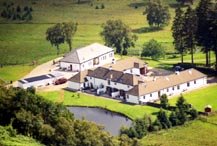Up here in the Highlands of Scotland bees are famous for producing Heather Honey. A particular type of honey due to it being produced from the nectar of only Heather, of which there is lots of - especially here in the Cairngorms National Park!
There was great excitement in the Cairngorms-Park.com team when they were informed that the CNPA were running an Introduction to Beekeeping Course in conjunction with Highland Bee Supplies (HBS) .
Unfortunately, Susan and Al could not make it, but I headed of to the Grant Arms Hotel in Grantown-on-Spey to learn about all things honey and buzzy. The course was split into two main sections, the morning involved classroom lectures presented by Neil from HBS. The class was very informative and all the students got involved in asking all types and levels of questions. The practical in the afternoon was great, it was very hand on, and we all got to handle a live hive with over 40,000 bees. We were supplied with all the protective clothing needed, suits or smocks, and gloves. Unfortunately one or two people got stung, but that's just life when handling 40,000 bees. Rest assured, I will be putting an order in for bees in 2011.
A big thank you to Andy from the CNPA for organising the event and also to the team from Highland Bee Supplies who put on a great course. If you get a chance, I would recommend going on this course, whether you plan to get bees or not. Anyone for honey?
Below are some picture of the training course and some little info snippets. As you can see the practical was REALLY hand on...it was great!
Honey is basically nectar with added enzymes. Nectar is the clear liquid that drops from the end of a flower blossom, which is 80% water with some complex sugars. The bees suck the nectar and once their stomach is full, they return to the hive or nest. The bees need to visit between 100 and 1500 flowers in order to fill their stomach. When full it holds almost 70 mg of nectar, which is almost as much as the bee weighs itself.
Once back at the hive, worker bees suck the nectar from the honeybees' stomachs, then "chew" the nectar for about half an hour. During this time, enzymes are passed into the nectar, breaking them down into simple sugars to make them more digestible for the bees. The nectar is then spread throughout the honeycombs where it evaporates into thick syrup, aided by the bees fanning it with their wings. Once the honey is thick enough, the bees seal off the cell of the honeycomb with wax and it is stored there ready to be eaten.
For more info snippets check out http://en.wikipedia.org/wiki/Beekeeping#Modern_beekeeping
For the great ecological and environmental benefits of bee keeping, check the Plan Bee Campaign by the co-op, yes the co-op www.co-operative.coop/ethicsinaction/takeaction/planbee/what-The-Co-operative-is-doing-for-bees/
--
Posted By Cairngorms National Park to Cairngorms Park on 8/02/2010 11:37:00 PM




No comments:
Post a Comment